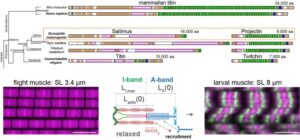In its final transformation, Drosophila emerges from the pupal case and unfolds its wings in a matter of minutes. Starting from a structure folded like origami, the wings open to form a flat, functional surface for flight.
During his thesis, and as part of a collaboration between IUSTI (Joël Marthelot), IRPHE (Marie-Julie Dalbe) and IBDM (Raphaël Clément), Simon Hadjaje was able to propose a first morphometric and mechanical description of this spectacular transformation. The wing, made up of two epithelial monolayers supported by pillars of microtubules and actin, pressurizes like an inflatable mattress under the action of the hemolymph flow caused by the increase in pressure. In addition to macroscopic folds unfolding, the wing surface stretches considerably during deployment.
At the cellular level, however, the wing is covered by a very rigid cuticle. We have observed that this cuticle is in fact wrinkled on a microscopic scale, enabling the wing’s apparent surface area to be increased without stretching it. Expansion thus relies on the stretching of the cells and the unwrinkling of the cuticle covering them, thus fixing the final size of the wing. We also discovered that the insect uses an operating point to achieve expansion with a relatively small pressure variation, thanks to both the structure of the wing and its non-linear mechanical characteristics.
Finally, we were able to show that the dynamics are limited by the viscoelastic properties of the tissue, which sets the time scale over which the unfolding takes place. Unlike classical morphogenesis processes based on cellular activity (growth, apoptosis, contractility, etc.), wing unfolding is a very rapid transformation of an entire organ, based on an increase in pressure triggered by the animal’s active behavior (air ingestion and muscular contractions). Hydraulic actuation, although essential for shape changes in plants, remains largely understudied in animal morphogenesis.
Hadjaje S, Andrade-Silva I, Dalbe MJ, Clément R, Marthelot J. Mechanics of Drosophila wing deployment. Nat Commun. 2024 Dec 11;15(1):10577.




